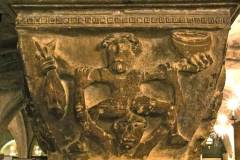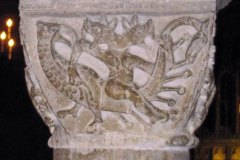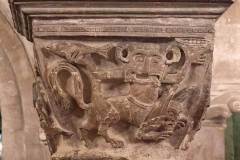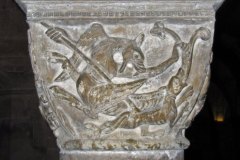The crypt at Canterbury is the largest and most striking in England. The western section (completed under Prior Ernulf around 1100) is built in the Norman (or Romanesque) style, and includes a large number of capitals (at the head of each pillar) decorated with strange Celtic pre-Christian images of animals, birds, griffins, dragons, monsters and men. It appears that these were cut, not by chisel, but with an axe, probably in a stone workshop and then hoisted in to place. Sixteen such carved columns stand in the western end of the crypt, approaching the Treasury. A further two stand in Gabriel’s chapel on the south side of the crypt, and two more in the chapel of the Holy Innocents on the north side. There are strong parallels between these images and those which appear in manuscripts of the period, in particular the so called ‘Bestiaries’ and images in ‘illuminated’ manuscripts.
St Gabriel’s chapel offers the striking combination of decorated capitals and surviving wall paintings. The capitals include strange images which are particularly difficult to interpret or explain. In particular, the depiction of animals playing musical instruments has parallels in early Egyptian art but the imagery is far from understood. At the time the Canterbury capitals were designed, the newly built choir had opened up possibilities for greater concentration on choral work and music in place of prayer and meditation – maybe some monks disliked this and were happy to see it lampooned?
What to see:
- animals playing musical instruments (Image 1) – the playing of harps by animals can be seen in the art of Thebes around 1500 BC
- grotesques playing musical instruments (Image 2) – the depiction could be of satyrs (mythical woodland creatures with ears of a horse or goat), representing lust and evil, whilst a stylised dragon bites the wrist of the player of the wind instrument
- two addorsed (back to back) winged grotesques (Image 3) – the animals, rising from a Celtic-style mask, have heads of jackals with bead-ornamented tails and scales, but are thought to represent stylised lions
- figure straddling two addorsed (back to back) beasts (Image 4) – here the animal tails curl round the capital edges in a composition (seated man between two beats) of great antiquity, even some claim derived from Sumerian and Assyrian art of 2500 BC
Source: see standard cathedral sources; also Kahn (1991); Vaux (1989)
For capitals in the western end of the crypt click here.
DL




